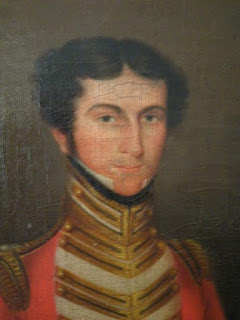KEEPING SHEEP: Jim Belshaw continues his story of the Taylor family, their world and the trials and tribulations of the early wool industry in New England
As
depression gripped NSW, the sprawling commercial and pastoral empire of Taylor's cousin Archibald
Clunes Innes came under pressure.
By 1843, he was in serious financial
difficulties. He managed to borrow the enormous sum of £29,000 pounds secured
by certain landholdings, his stores at Armidale and Port Macquarie, his
household furniture, carriages and other personal effects. That stabilized the
position for the present.
Photo: Archibald Clunes Innes as a young man. The commercial empire he founded and the life style at Lake Innes, his Port Macquarie headquarters, provide one of the themes in our story.
Later in
1843, the large mercantile firm of Messrs Hughes and Hoskings, one of those who
had lent money to Innes, failed. The firm owed £155,000 to the Bank of
Australia and its failure pulled the Bank down, adding to the economic woes.
In 1844, the
commercial, shipping and pastoral empire of Joseph Grose failed.
We first met
Grose when he commissioned the construction of the William the Fourth, the Billy, the first steamer built in NSW (1831) and a familiar
sight on the Port Macquarie run. This was followed by the purchase of the Sophia Jane, another familiar ship to
those living at Port Macquarie and in the southern New
England .
The drought
that gripped NSW in the late 1830s affected Grose, as did the decline in stock
prices. His Hunter
River
In addition
to the funds borrowed from Messrs Hughes and Hoskings, the £29,000 borrowed by Innes
in 1843 included substantial contributions from the Macleay and Dumaresq
families. Innes was married to Margaret Macleay, while William Dumaresq had
married Margaret’s sister Christiana Susan.
Henry
(1792-1838) and William John Dumaresq (1793-1868), were the sons of Colonel
John Dumaresq. Both went to the Royal Military College ,
Great Marlow, and served during the Peninsular War and in Canada
Photo: The Dumaresq River in Northern New England, Southern Queensland, Armidale's Dumaresq Creek and the previous Dumaresq Creek are just some of the features named after the Dumaresqs
Between
1818 and 1825, Henry served in Mauritius New South Wales
The two
brothers each built up considerable estates in the Hunter
Valley , while also acquiring the large
New England runs of Saumarez and Tilbuster,
thus establishing the now familiar Dumaresq name in the Armidale district.
Both
brothers established reputations as effective and indeed kindly managers who
looked after their staff, convict and free. “The result of such a system is
just what might be expected”; wrote John Dunmore Lang, “the men are sober,
industrious and contented”
While the
loans from the Macleay and Dumaresq families were helping stabilize Archibald Innes’s
position, William Tydd Taylor Margaretta Lucy Lind were taking the next step in
their own journey.
William had
purchased Middleton’s interest in Terrible
Valley in November 1843. With full ownership, he began construction of the
first Taylor
Note to readers: This post appeared as a column in the Armidale Express Extra on 8 June 2016. I am repeating the columns here with a lag because they are not on line outside subscription. You can see all the Belshaw World and History Revisited columns by clicking here for 2009, here for 2010, here for 2011, here for 2012, here for 2013, here for 2014, here for 2015, here for 2016.












No comments:
Post a Comment